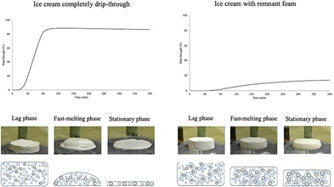 Your new post is loading...

|
Scooped by
Pôle Veille AgroParisTech
September 9, 5:37 AM
|
Veille IPCI : Ingénierie de Produits à l'interface Cuisine-industrie

|
Scooped by
Pôle Veille AgroParisTech
September 30, 5:10 AM
|
À l’occasion de cette première édition d’ELO Produits laitiers, la rédaction de Process Alimentaire, entourée d’experts et d’acteurs industriels, décrypte les grands enjeux et perspectives dans le domaine des laits, desserts, fromages et aides culinaires.

|
Scooped by
Pôle Veille AgroParisTech
September 30, 5:07 AM
|
Plant-based alternative brands are missing opportunities to attract consumers due to a lack of new flavor innovation. A gap has emerged between consumer expectations of taste and flavor in alt-meat and alt-dairy categories and what brands are delivering, contributing to market stagnation but also creating opportunities for brands to shine in a competitive arena.

|
Scooped by
Pôle Veille AgroParisTech
September 30, 5:02 AM
|
Le collagène est devenu un ingrédient phare du marché « nutricosmétique » et bien-être, considéré non plus seulement comme un atout beauté mais comme un véritable support de santé préventif pour une population à la fois active et vieillissante.

|
Scooped by
Pôle Veille AgroParisTech
September 30, 4:56 AM
|

|
Scooped by
Pôle Veille AgroParisTech
September 30, 4:48 AM
|
Natural protein–polysaccharide complexes (PPCs) have emerged as promising next-generation emulsifiers for oil-in-water (O/W) emulsions, simultaneously meeting functionality and safety requirements in contemporary food systems. As consumer and regulatory focus intensifies on clean-label formulations, nutritional enhancement, and environmental sustainability, PPC-based emulsifiers offer a biocompatible alternative to synthetic or single-component stabilizers. Citation : Liu, Y., Y. Liu, M. Zhong, et al. 2025. “ Protein–Polysaccharide Complexes for O/W Emulsions: Structural Engineering and Their Relevance to Food Stability and Safety.” Comprehensive Reviews in Food Science and Food Safety 24, no. 5: e70289. https://doi.org/10.1111/1541-4337.70289

|
Scooped by
Pôle Veille AgroParisTech
September 22, 8:49 AM
|
This interactive event addresses the future of sustainable food nutrition through the lens of hands-on product development.

|
Scooped by
Pôle Veille AgroParisTech
September 22, 8:41 AM
|
Pickering emulsion, stabilized by solid particles, is a promising emulsion system of great significance. It has attracted much attention in the food field because of its strong stability, environmental friendliness, and other advantages. This paper focuses on the Pickering emulsion stabilized by different solid particles, including proteins, polysaccharides, and polyphenols. Citation: Liu, S., F. Chen, Y. Huang, et al. 2025. “ The Modification and Application of Food Grade Pickering Emulsion.” Journal of Food Science 90, no. 9: e70562. https://doi.org/10.1111/1750-3841.70562

|
Scooped by
Pôle Veille AgroParisTech
September 22, 8:26 AM
|
Using a unique longitudinal sampling approach, Louw et al. demonstrate how a cheese-associated Penicillium population has adapted in an artisan cheese production facility in Vermont, USA. Adaptation is marked by a striking loss of pigmentation and melanin mutations. by Louw, Nicolas L. et al., in Current Biology

|
Scooped by
Pôle Veille AgroParisTech
September 22, 2:06 AM
|
The integration of artificial intelligence (AI) with nuclear magnetic resonance (NMR) spectroscopy is emerging as a transformative approach in food component analysis, offering innovative solutions for ensuring food quality and safety. by Ruge C. & al. in Trends in Food Science & Technology, Volume 156, February 2025, 104852

|
Scooped by
Pôle Veille AgroParisTech
September 15, 6:07 AM
|
Co-creation has gained attention for its potential to develop new food products that align with consumer expectations and acceptance.

|
Scooped by
Pôle Veille AgroParisTech
September 15, 6:02 AM
|
This synthesis offers new insights into the complexity of gastronomic professionalism and calls for greater interdisciplinary engagement with sommellerie as an evolving field of aesthetic, ethical, and embodied knowledge.

|
Scooped by
Pôle Veille AgroParisTech
September 15, 5:58 AM
|
La protéine est partout. Explorons les raisons de cette tendance, le profil des consommateurs visés, et les limites nutritionnelles qu’elle présente.
|
The global food industry is undergoing a profound transformation. As consumers become more health-conscious, environmentally aware, and digitally connected, the demand for nutritious, transparent, and functional food is reshaping how products are developed, labelled, and consumed. From precision fermentation to smart packaging and ancient botanicals, a new generation of innovations is redefining what it means to eat well.

|
Scooped by
Pôle Veille AgroParisTech
September 30, 5:09 AM
|
Comprendre le comportement de fusion est essentiel pour les fabricants qui cherchent à optimiser les formulations et les conditions de traitement des crèmes glacées.

|
Scooped by
Pôle Veille AgroParisTech
September 30, 5:04 AM
|
Protein development is entering a new phase, driven by both consumer demand and industry requirements. Consumers are no longer satisfied with novelty alone — they expect protein to provide taste, function, and health benefits while also remaining cost-effective.

|
Scooped by
Pôle Veille AgroParisTech
September 30, 4:59 AM
|
This review examines the potential chemical hazards associated with plant-based alternatives, including naturally occurring toxins in plant-based ingredients and their residual presence in the final product, agrochemical and other environmental toxicants, novel ingredients and processing-derived compounds. It further highlights critical research gaps, including the need to identify potential chemical toxicants in plant-based analogs and to elucidate the long-term consequences of their consumption.

|
Scooped by
Pôle Veille AgroParisTech
September 30, 4:50 AM
|
Microfluidization (MF) is a versatile technique that is widely used in food engineering. It stands out for emulsion homogenization, encapsulation, bioactive compound extraction, and creating nano- and microsized food components. Additionally, MF is a recognized method for modifying protein structures and their functional properties.

|
Scooped by
Pôle Veille AgroParisTech
September 30, 4:28 AM
|
Consumer demands for fresh and minimally processed liquid foods that support disease prevention and promote health emphasize the need for innovative processing technologies that ensure microbiological safety and preserve bioactive compounds. In addition, consumers are becoming more concerned about the presence of chemical additives in liquid foods. Non-thermal processing technologies, including high-pressure processing, high-pressure homogenization, pulsed electric field, pulsed magnetic field, high-pressure carbon dioxide, ultrasound treatment, radiation processing, ozone processing, cold plasma, and membrane processing, offer excellent prospects for the application in liquid foods.

|
Scooped by
Pôle Veille AgroParisTech
September 22, 8:43 AM
|
This study explored superheated steam (SHS) as an alternative to pan-frying for preparing ready-to-eat beef steaks (RBS). Compared to pan-fried RBS, SHS significantly reduced hardness, chewiness, and lipid/protein oxidation while improving springiness and tenderness. Citation : Jiyuan He, Lunzhou Lin, Jiebin Cai, Chengjun Liu, Yaming Xiao, Yajie Shen, Binxiong Liu, Ting Fang, Ready-to-eat beef steaks prepared by superheated steam: from texture and flavor to storage stability, International Journal of Gastronomy and Food Science,
Volume 42, 2025, https://doi.org/10.1016/j.ijgfs.2025.101285

|
Scooped by
Pôle Veille AgroParisTech
September 22, 8:37 AM
|
During food consumption, tastes combine with retronasal odours to form flavour, which leads to a link so robust that retronasal odours can elicit taste sensations without concurrent taste stimulation. However, the cortical integration of these parallel sensory signals remains unclear. Citation: Khorisantono, P.A., Veldhuizen, M.G. & Seubert, J. Tastes and retronasal odours evoke a shared flavour-specific neural code in the human insula. Nat Commun 16, 8252 (2025). https://doi.org/10.1038/s41467-025-63803-6

|
Scooped by
Pôle Veille AgroParisTech
September 22, 2:07 AM
|
Fermentation has traditionally been understood as a yeast-driven transformation that alters a product's characteristics, including all microbial processes used across various industries (Reboleira et al., 2021). Initially, fermentation occurred through the activity of naturally occurring microbes in the product. However, modern fermentation processes now employ specific microbial strains or commercial starter cultures to improve predictability, efficiency, and safety. Citation: Srutee Rout, Prem Prakash Srivastav, Recent trends in the production of proteins by precision fermentation for improving the quality and attributes of food: Role of genetic engineering towards next generation of food production, The Microbe, Volume 8, 2025,
https://doi.org/10.1016/j.microb.2025.100551.

|
Scooped by
Pôle Veille AgroParisTech
September 18, 3:46 AM
|
La viande occupe une place centrale dans les repas festifs. Et si la réussite de notre transition alimentaire passait par la transformation du repas gastronomique ?

|
Scooped by
Pôle Veille AgroParisTech
September 15, 6:05 AM
|
La gélatine résulte d’une extraction à partir de collagène, majoritairement d’origine porcine et bovine, réalisée grâce à des process complexes. Cet article a pour objectif de passer en revue les différentes opérations unitaires mises en œuvre. Voir aussi l'article Gélatine alimentaire - Réglementation, marchés et propriétés

|
Scooped by
Pôle Veille AgroParisTech
September 15, 6:01 AM
|
Yesterday, the EU Parliament’s Agriculture Committee voted on a motion to “strengthen the position of farmers in the food supply chain.”

|
Scooped by
Pôle Veille AgroParisTech
September 15, 5:54 AM
|
De Magaly Angénieux, Alyssa Bouville, Frédéric Mercier, Adeline Laleuw, Sylvie Chevolleau, Laurent Debrauwer, Valérie Scislowski, Maïa Meurillon (2025). Quantification of process-induced toxicants in bovine meats cooked according to the usual preparation and cooking practices in France. Food Control, Volume 176, 111374.
|





 Your new post is loading...
Your new post is loading...




![Multi-actor co-creation of innovative protein-rich appetisers for older adults: From the kitchen to real-life consumer tasting [Food Quality and Preference] | IPCI : Ingénierie de Produits à l'interface Cuisine-Industrie | Scoop.it](https://img.scoop.it/c_JcV5nluzCz2LP1VEWuOjl72eJkfbmt4t8yenImKBVvK0kTmF0xjctABnaLJIm9)




![Ready-to-eat beef steaks prepared by superheated steam: from texture and flavor to storage stability [International Journal of Gastronomy and Food Science] | IPCI : Ingénierie de Produits à l'interface Cuisine-Industrie | Scoop.it](https://img.scoop.it/kdibHy8Uw3rw68SLFdFZwDl72eJkfbmt4t8yenImKBVvK0kTmF0xjctABnaLJIm9)
![Recent trends in the production of proteins by precision fermentation for improving the quality and attributes of food [The Microbe] | IPCI : Ingénierie de Produits à l'interface Cuisine-Industrie | Scoop.it](https://img.scoop.it/QzDpOGYG32QHBICaSBz5BDl72eJkfbmt4t8yenImKBVvK0kTmF0xjctABnaLJIm9)


![Développement de composés néoformés dans la viande bovine lors de la cuisson [Food Control] | IPCI : Ingénierie de Produits à l'interface Cuisine-Industrie | Scoop.it](https://img.scoop.it/B5NQ3Zw1e415HyP2E9Wgyzl72eJkfbmt4t8yenImKBVvK0kTmF0xjctABnaLJIm9)




